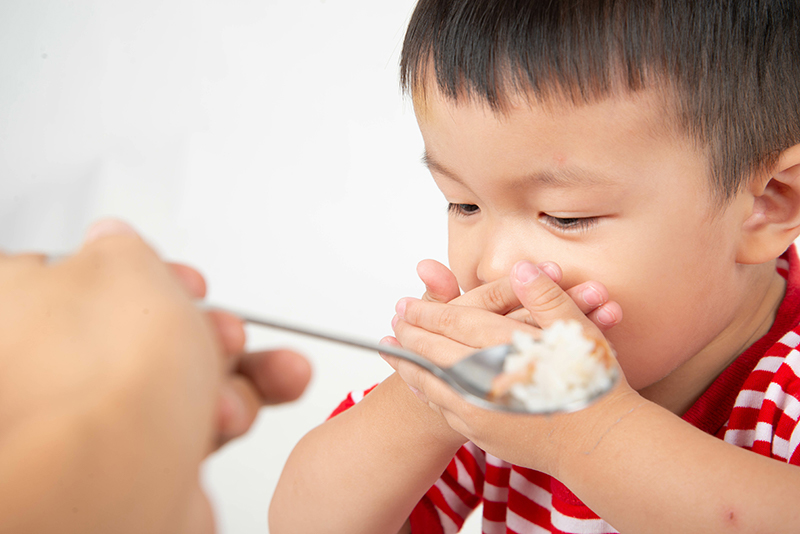Picky Eating
Is your child picky?
Learn about the range of picky eating – from normal to extreme – and what to do about it.
Young children are often cautious about food. They may refuse to eat new foods and familiar foods alike. Essentially, all foods are unfamiliar when viewed from a toddler’s perspective. Skepticism of new or different foods is developmentally normal for children as they enter toddlerhood. Think of it from a historical perspective. As children reach the age when they are mobile, they spend less time under the watchful care of their parents. As they seek food for themselves, survival depends on fear of the unknown – with food and everything else.
In our modern world, young children are constantly under the watchful care of their parents or another responsible adult. It’s stressful for the adult observer to see the child go from being an avid eater to refusing foods, seemingly overnight. When the food list shrinks to very few foods, parents often want to know what to do. How do I get my kid to eat?
Normal picky eating
Health professionals have varying definitions for picky eating. What most agree on is that picky eating exists on a continuum from normal childhood eating behavior to extreme or problematic eating behavior that can affect nutrition status and may need professional treatment. For the majority of children, their “cautious” eating is normal and to be expected.
Satter considers picky eating something to be expected as a normal part of child development. Normal picky eating is when a child eats one or two foods while ignoring others, eats a food one time and not another, and it can take several neutral exposures before they decide to try or eat a food.
What to do if your child is a normal picky eater:
Follow the Satter Division of Responsibility in Feeding. Think of your child as an adventurous learner or a cautious learner (or somewhere in-between) and provide lots of safe opportunities to explore new foods. Be sure to include your child at meals, provide a variety of foods (some new and some familiar), cut or prepare foods so your child can work to feed themselves and stay calm.
Finicky eating
Satter delineates normal picky eating from problematic eating. “Finicky” eating is problematic, and is observed when a child behaves poorly at meals; has a short-list of acceptable foods or become stuck on eating a few favorite foods; gets upset by unfamiliar foods; and/or refuses to eat past favorite foods. As a parent, you may feel compelled to make special food for your child, or even become aggravated and coercive, applying lots of pressure in efforts just to get them to eat something.

Additional strategies for feeding a cautious eater:
- Do your job with feeding (what, when and where) and allow your child to do their job with eating (whether and how much).
- Have regular meals and sit-down snacks so your child can be ready to eat at mealtime. Provide only water to drink between times.
- Instead of asking your child what they want to eat, you decide what is offered at the meal. Include one or two foods that your child usually eats. Include new foods in small amounts. Resist the urge to make special food or a separate meal for your child. This limits your child’s chances to explore new foods.
- Remind them, “You don’t have to eat, but you do need to join us at the table.” Let them eat what they want to eat from the food that is offered, even if that means they fill up on one food or choose to eat nothing at all.
- Avoid pressuring your child to eat. Do not bribe, encourage, cheer-lead, reward, force them to eat a certain number of bites, glare, punish, deprive, deceive, make a big deal of loving the food, or make comments about their picky eating or bring attention to their likes and dislikes. Trust your child when they say their finished.
- Give them a way out when trying new foods. Provide a napkin so they can remove food from their mouth that they don’t care for.
- Make meals a pleasant experience by setting expectations that include teaching children how to behave at mealtime and how to politely turn down foods. Even if they choose not to eat, remind them that their presence at mealtime is important to you.
- Adjust your expectations. See your child as cautious instead of picky. Provide opportunity for learning and trust them to come along with their eating.
Is your child picky?
Learn about the range of picky eating – from normal to extreme – and what to do about it.
Young children are often cautious about food. They may refuse to eat new foods and familiar foods alike. Essentially, all foods are unfamiliar when viewed from a toddler’s perspective. Skepticism of new or different foods is developmentally normal for children as they enter toddlerhood. Think of it from a historical perspective. As children reach the age when they are mobile, they spend less time under the watchful care of their parents. As they seek food for themselves, survival depends on fear of the unknown – with food and everything else.
In our modern world, young children are constantly under the watchful care of their parents or another responsible adult. It’s stressful for the adult observer to see the child go from being an avid eater to refusing foods, seemingly overnight. When the food list shrinks to very few foods, parents often want to know what to do. How do I get my kid to eat?
Normal picky eating
Health professionals have varying definitions for picky eating. What most agree on is that picky eating exists on a continuum from normal childhood eating behavior to extreme or problematic eating behavior that can affect nutrition status and may need professional treatment. For the majority of children, their “cautious” eating is normal and to be expected.
Satter considers picky eating something to be expected as a normal part of child development. Normal picky eating is when a child eats one or two foods while ignoring others, eats a food one time and not another, and it can take several neutral exposures before they decide to try or eat a food.
What to do if your child is a normal picky eater:
Follow the Satter Division of Responsibility in Feeding. Think of your child as an adventurous learner or a cautious learner (or somewhere in-between) and provide lots of safe opportunities to explore new foods. Be sure to include your child at meals, provide a variety of foods (some new and some familiar), cut or prepare foods so your child can work to feed themselves and stay calm.
Finicky eating
Satter delineates normal picky eating from problematic eating. “Finicky” eating is problematic, and is observed when a child behaves poorly at meals; has a short-list of acceptable foods or become stuck on eating a few favorite foods; gets upset by unfamiliar foods; and/or refuses to eat past favorite foods. As a parent, you may feel compelled to make special food for your child, or even become aggravated and coercive, applying lots of pressure in efforts just to get them to eat something.

Additional strategies for feeding a cautious eater:
- Do your job with feeding (what, when and where) and allow your child to do their job with eating (whether and how much).
- Have regular meals and sit-down snacks so your child can be ready to eat at mealtime. Provide only water to drink between times.
- Instead of asking your child what they want to eat, you decide what is offered at the meal. Include one or two foods that your child usually eats. Include new foods in small amounts. Resist the urge to make special food or a separate meal for your child. This limits your child’s chances to explore new foods.
- Remind them, “You don’t have to eat, but you do need to join us at the table.” Let them eat what they want to eat from the food that is offered, even if that means they fill up on one food or choose to eat nothing at all.
- Avoid pressuring your child to eat. Do not bribe, encourage, cheer-lead, reward, force them to eat a certain number of bites, glare, punish, deprive, deceive, make a big deal of loving the food, or make comments about their picky eating or bring attention to their likes and dislikes. Trust your child when they say their finished.
- Give them a way out when trying new foods. Provide a napkin so they can remove food from their mouth that they don’t care for.
- Make meals a pleasant experience by setting expectations that include teaching children how to behave at mealtime and how to politely turn down foods. Even if they choose not to eat, remind them that their presence at mealtime is important to you.
- Adjust your expectations. See your child as cautious instead of picky. Provide opportunity for learning and trust them to come along with their eating.
